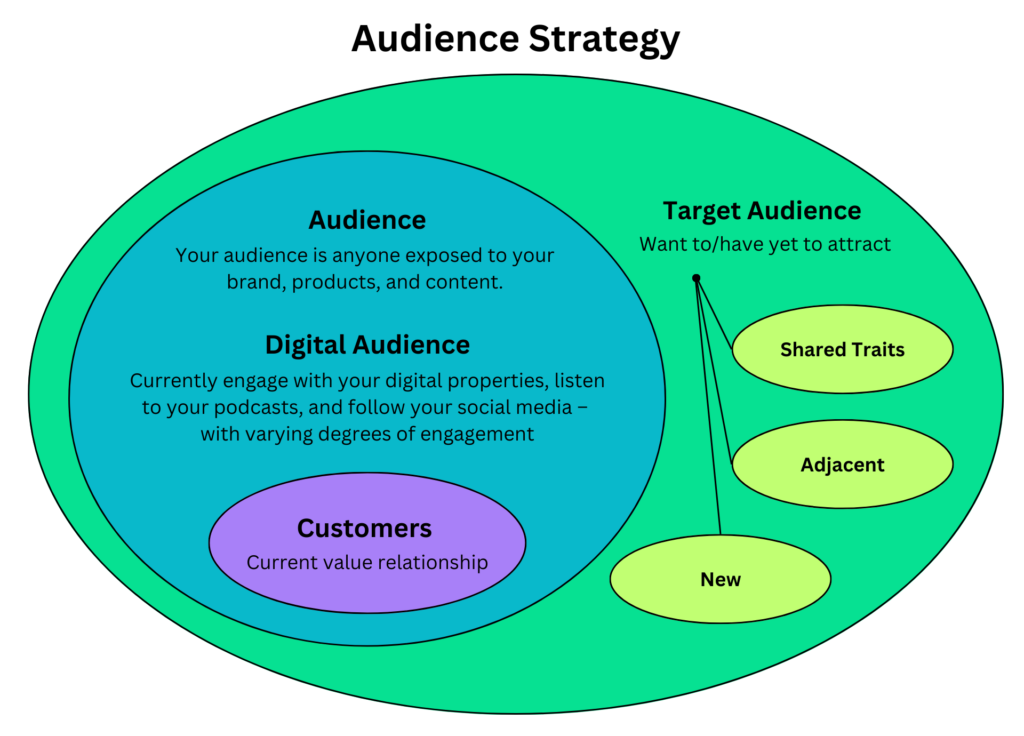What is Audience Strategy?
Recently we have seen “audience strategy” enter the lexicon of scholarly and professional publishers and associations. This buzzy term is shorthand for the process of identifying and understanding both your current and potential customers’ interactions with your brand, products, and content – and using this information to improve engagement.
While newer to our industry, audience-centric strategies have been around for a while. For example, consumer publishers depend on highly engaged audiences to support the longevity and growth of their individual (business to consumer or B2C) and enterprise (business to business or B2B) subscriptions, as well as advertising business models. These publishers focus on strategies such as personalized recommendations and multi-channel marketing (e.g., newsletters, apps, on-site, social) to increase the frequency and intensity of engagement by their readers. And these strategies drive results – research from the Lenfest Institute of Journalism shows a direct correlation between engagement levels and subscription purchase and renewal.[1]
Similarly, e-commerce businesses use audience-centric strategies to attract new customers and cultivate loyalty that in turn increases customer purchases and word-of-mouth referrals. These retailers gather audience intelligence and use it as the basis for segmentation, delivering personalized offers and recommendations and building loyalty programs that are embraced by customers.
For scholarly and professional publishers and associations, the recent shift to open access business models has resulted in authors becoming not only suppliers but primary customers. This shift has led to increased customer expectations, and tough competitive dynamics that have catapulted audience strategy into the spotlight. While there are clear (and important) differences between the scholarly and professional world and the consumer media and ecommerce sectors, we can learn a lot from how these organizations have moved beyond focusing solely on their customers to focusing on their audience.
How is Audience Strategy Different from Customer Strategy?
As the below diagram shows, an audience strategy focuses on three groups: your audience, your customers, and your target audience. To better understand what an audience strategy entails, let’s look at each of these groups in more depth.

Customers
A customer is an individual with whom a brand has a value exchange relationship. The traditional definition of customer was limited to commercial relationships (usually purchases). In recent years, this definition has broadened to include any relationship that involves an exchange of value between an individual and a brand. For publishers and associations, customers go beyond authors, subscribers, product purchasers, members, and event attendees to include those who volunteer time (reviewers, external editors, and editorial board members) and those who choose to provide their personal data (e.g., email address) to access a brand’s content (e.g., email subscribers or blog subscribers).
Customers represent the highest-value relationship that a brand has with an individual. Since it is often easier to nurture and grow an existing customer relationship than to form a wholly new one, and as happy customers (including authors!) can be converted into brand evangelists, ongoing engagement with customers is critical.
Audience
Your audience is anyone exposed to your brand, products, and content. For the purposes of this article, when we reference “audiences”, we are referring to digital audiences. Your digital audience is comprised of all the individuals who engage with your digital properties (e.g., websites, blogs, community platforms, podcasts, social media channels, etc.). Different audience members exhibit varying degrees of engagement, from occasional engagers to super users who interact frequently and deeply with your content.
Your audience includes your current customers – but it can also include individuals who are not yet customers. Many content-centric organizations have a substantial percentage of unknown (anonymous) audience members. For example, it is common for journal publishers to identify less (and often far less!) than 20% of their journal readership. This is because few readers see the benefits of logging in, with access to content available via institutional subscriptions, repositories, or open access.
Most publishers track their anonymous users, analyzing and reporting on patterns and trends at an aggregate level (e.g., institution, journal, topic, or article), but there has been less focus on understanding anonymous visitors as individuals with unique traits and characteristics gleaned from behavioral data. For example, a publisher may know that a specific article has 1,000 downloads from Stanford University, but not know who is downloading the article.
Harnessing Audience Intelligence
As readers browse websites, they are leaving digital fingerprints. This treasure trove of data is “audience intelligence” that enables organizations to move from intuition to data-driven decision making and strategy. Even when you do not know specifically who someone is (because they are not logged in), you can know a lot about them – for example:
- institutional affiliation
- geography
- affinity (i.e., interest) with topics, products, and formats
- preference for specific marketing channels, messages, or offers
- content engagement and activity levels
- specific event completion (e.g., clicked button, watched video, downloaded article)
- behavioral signals (e.g., scroll time on a page, number of pages viewed)
This information can help shape marketing and content strategies.
Enriching Audience Intelligence
A core tenet of an audience strategy is audience data enrichment achieved through the purchase or license of external data sources. Enrichment is in service to two primary goals:
- Increasing identification rate of one’s audience (i.e., moving “unknown to known”): Whereas customers are always identified, audience members can be identified or anonymous.
- Adding data to fill in missing information: For example, adding to an audience profile an email address, physician-level data, or information about an author’s publishing track record.
A higher percentage of identified users, along with more robust audience profile data, improves marketing performance, deepens audience intelligence, and supports advertising business models.
Activating Audience Intelligence
The use of audience intelligence for segmentation, personalization, recommendations, and omni-channel (e.g., email, web, social, etc.) orchestration is known as “activation.” For example, with the right MarTech (marketing technology), marketers can trigger on-the-fly web personalization and recommend content to audience members that fit defined audience targeting parameters – whether those audience members are identified (known customer profiles) or anonymous (unknown audience profiles).
For example, for an upcoming special issue on atrial fibrillation (A-fib), a journal marketer might want to trigger an ad to researchers with an affinity towards the topic “A-fib”. This affinity is built based on how the researcher has historically engaged with A-fib content and campaigns. Based on the rules that are set, marketers can trigger personalized messages across all relevant channels to anyone in the A-fib audience (both known and unknown members).
To maximize campaign success, the marketer will need to think carefully about the messaging, channel, and targeting strategy that underpins the campaign. For example, they might:
- Pull messaging from a message library to test different submission benefits
- Display a different creative and/or message to three author segments – first-time authors, repeat authors, and VIPs (frequent authors and/or peer reviewers)
- Alert audience members who are affiliated with an institution with a transformative agreement (TA) that they can publish for free in this A-fib special issue
- Work with membership to plan and coordinate an integrated campaign that advances both author submissions and member loyalty (in this scenario, an APC discount offer would be shown only to members as a benefit of membership)
Target Audience
These are the individuals who organizations wish to attract but have yet to do so, and they are often the primary focus of organizations’ outreach strategy. Marketing teams use myriad tactics (e.g., paid media, SEO, events, PR, content marketing, community engagement, and social media) to attract new audience members, testing different messaging and outreach channels to maximize the return on investment of their efforts and refine their outreach approach over time. Additionally, in this competitive OA world, it has become critical for editors to use data-driven business development and community building techniques to find and engage with target (prospective) authors in order to increase high-quality submissions.
Target audiences can be in new areas, or they can include individuals who share characteristics with your current audience – such as topical interests, web behavior, and demographic factors like geographic location, job function, or career level. Audience intelligence can help you discover these “look-alikes,” optimizing paid media expenditure.
The Audience Journey
Audience engagement advances individuals through “journeys” – moving targets into an organization’s audience, converting audience members into customers, and then using those customers’ positive word of mouth and referral to attract new audiences. These journeys can be windy and complex. AI and predictive algorithms can help organizations to deliver the right message at the right time to the right customer, and in the right channel – fully optimizing journey advancement.
In two recent articles, both Wiley[2] and Elsevier[3] have talked about personalized author journeys to increase author engagement and author experience. We very much agree that AI-driven multi-channel author journeys are critical for audience engagement and author experience. We particularly appreciate the candor in which Bill Deluise (Wiley’s Corporate VP of Integrated Marketing) shares the long and hard process involved in mapping and building author journeys.
How to Cultivate an Audience Mindset
Break Siloes
The first and most important shift is to recognize that an audience strategy (and customer strategy) cannot be fragmented across the organization. The same individual can wear, and usually does wear, numerous hats in their interactions with your organization (member, reader, event attendee, author, etc.). While there could be millions of segments across an organization, there is only one audience.
Siloed marketing and communications teams need to come together through hub and spoke strategies that leverage common customer and audience data infrastructures and campaign planning processes. This holds true for organizations where both Marketing and Editorial are engaging in outreach. In addition, associations with outsourced publishing need to work closely with their publishing partner to minimize fragmentation across their websites. Associations should have the ability to collect and use all their audience data.
Prioritize Data
The foundation for audience intelligence and activation is the collection and unification of audience data. Owned data including first-party data (from customer transactions and behavioral listening) and zero-party data (data and preferences that customers share) are critical planks in this customer/audience data foundation.
As organizations mature, they should enrich their owned data with 2nd or 3rd party data sources – purchased or licensed – enabling them to identify a larger percentage of readers and append useful information to customer and audience profiles.
Tools are Needed
Modern marketing is inextricably connected to marketing technology (MarTech). An audience strategy is fundamentally a data-driven approach to marketing and digital experience. It relies on marketing technology that not only collects and unifies data, but also provides tools for marketers to activate it (i.e., easily spin up emails, trigger web ads, build segments for paid media, etc.).
Traditional association management systems (AMSs), customer relationship management systems (CRMs), and marketing automation platforms alone are insufficient to support a modern audience strategy. Organizations need to take a fresh look at their current MarTech (marketing technology) stack – best achieved through a capability audit – and determine what they need to keep, add, or replace.
As far as the tools go, there is no single solution. Rather, results are achieved by:
- Clear articulation of the business case for change, and a roadmap of how to get there. You must have a clear vision anchoring your strategy and tool selection.
- The careful selection of the right tools – ideally through a robust marketing-led RFI process. For any given need, there are numerous tools that can do the job – each with their own trade-offs and considerations. The devil is in the details.
- Taking a crawl, walk, and then run approach to adopting MarTech. You can have an ambitious vision, but you need to take it one step at a time. A single customer view is a vision – not a use case. Start with the highest priority use cases and only bring into the system the data that needs to be collected to serve those use cases. Once you prove value, you can move on to your next set of use cases. Avoid big projects that boil the ocean.
- Partnering with IT to ensure all tools in the MarTech stack work in harmony with the enterprise architecture. Tools that do not integrate or that result in fragmented audience data are likely to prove counterproductive.
- Most importantly, building the right structures, skills, processes, and strategies to derive as much value as possible from the new technology. This is the hard part – the tools themselves do not improve marketing. Technology is just an enabler. Marketers need to know how to use the tools to be successful.
Think Omni-Channel
The best audience engagement campaigns are omni-channel. With the right audience strategies your marketing is not bound by one channel.
- A message can appear across websites for each of a society’s individual journals, its blog, and its main society website. The channel rules are not set on a specific website, but rather, on all the sites an individual visits that meet defined targeting parameters.
- Campaigns can trigger emails and email campaigns can include personalized content and product recommendations.
- Omni-channel campaigns can include SMS (text), push messaging (browser or in-app), and paid media.
The right tools can help determine the appropriate channel and message, and even send hyper targeted lists to social media and ad networks to build custom audiences and look alikes.
Invest in Audience Engagement
Organizations must recognize the importance of audience engagement and adequately invest in it. At its most basic level, engagement supports increased traffic, which supports institutional sales opportunities and renewals. It increases the likelihood that an audience member will sign up to an email list or will provide valuable zero-party data (e.g., medical specialty). Numerous studies have shown a direct correlation between high engagement level and the likelihood of an audience member becoming a paying customer (e.g., an author, member, event attendee, subscriber, or product purchaser). In addition, audience engagement is “table-stakes” for organizations with advertising or sponsorship business models.
Scholarly and professional publishers and associations spend significantly less than consumer media and ecommerce companies on marketing. Their MarTech stacks are smaller and less sophisticated. As the sector starts to understand the importance of audience engagement, expenditure will likely need to increase.
Appropriate Messaging
To effectively engage with audiences and convert audiences to customers, it is essential to use the right message. Messaging must be tuned to both the audience segment and the context. It is ideally linked to an organization’s brand and positioning strategy and validated with audience research.
We are big proponents of values-based message libraries (we call our framework for this a Capsule Messaging Collection™). This values-oriented messaging is an important plank in personalization, testing, and optimization agendas. When you blend the art of good messaging and content with the science of testing messaging to diverse audience segments, the audience-engagement magic happens.
In Summary
Organizations that achieve audience-centricity will have a competitive advantage. High audience engagement can lead to a virtuous cycle amplifying the significance of your content, brand, and products within your community. Robust audience intelligence creates a culture of continuous improvement for marketing and content strategies.
Reach out to info@ce-strategy.com for more information on how we can help you take your audience strategy to the next level.
[1] Lenfest Institute of Journalism Reader Revenue Benchmarks
[2] Natasha White: “Personalizing the journal author experience—the right message at the right time,” Wiley, 20 January 2023.
[3] Judy Allen and Stephen Wymbs: “The evolution of author marketing for scholarly journals: How we use data to reach the right authors with the right message at the right time,” Elsevier, 15 December 2022.




